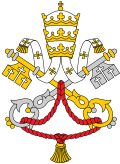1588 apostolic constitution by Pope Sixtus V
Immensa aeterni Dei ("The immeasurable [wisdom of] the eternal God") is an apostolic constitution in the form of a papal bull issued by Pope Sixtus V on 22 January 1588. The constitution reorganized the Roman Curia, establishing permanent congregations of cardinals to advise the pope on various subjects.
